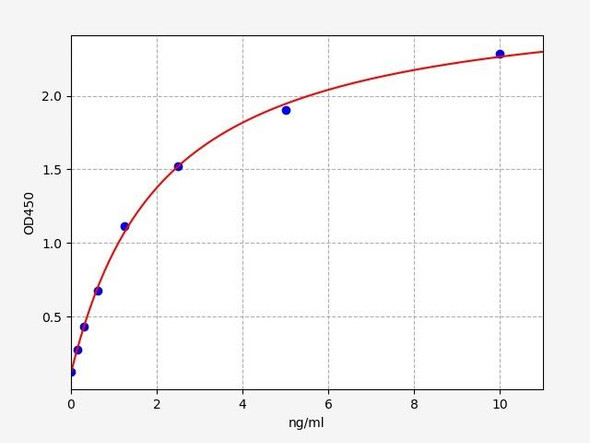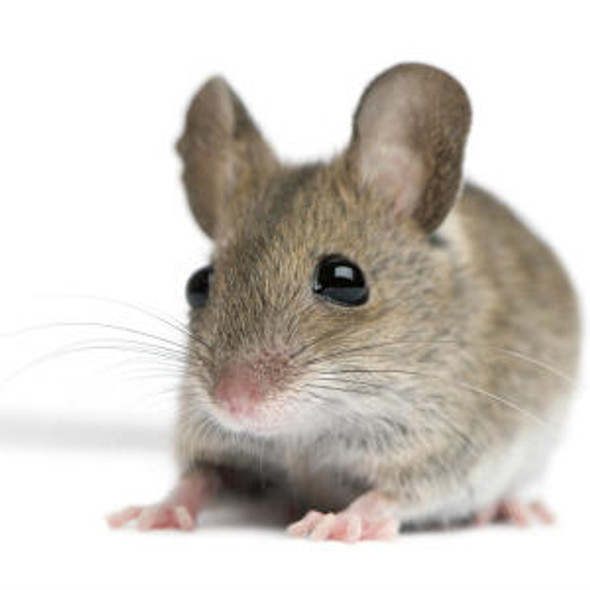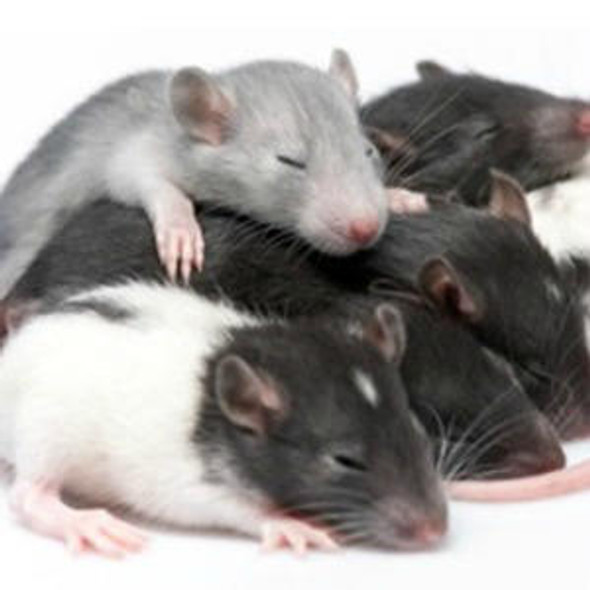Human OGG1 (8-Oxoguanine Glycosylase 1) ELISA Kit (HUES02882)
- SKU:
- HUES02882
- Product Type:
- ELISA Kit
- Size:
- 96 Assays
- Uniprot:
- O15527
- Sensitivity:
- 0.09ng/mL
- Range:
- 0.16-10ng/mL
- ELISA Type:
- Sandwich
- Synonyms:
- HMMH, HOGG1, MUTM, OGH1, 8-Oxoguanine DNA Glycosylase
- Reactivity:
- Human
- Sample Type:
- Serum, plasma and other biological fluids
- Research Area:
- Epigenetics and Nuclear Signaling
Description
Human OGG1 (8-Oxoguanine Glycosylase 1) ELISA Kit
The Human OGG1 (8-oxoguanine glycosylase 1) ELISA Kit is designed for the precise measurement of OGG1 levels in human samples including serum, plasma, and cell culture supernatants. This kit offers exceptional sensitivity and specificity, ensuring accurate and consistent results for various research purposes.OGG1 is a vital enzyme responsible for repairing DNA damage caused by oxidative stress, specifically targeting 8-oxoguanine lesions. Dysregulation of OGG1 has been linked to various diseases such as cancer, neurodegenerative disorders, and aging, highlighting its importance as a biomarker for studying and potentially treating these conditions.
The Human OGG1 ELISA Kit provides researchers with a valuable tool for analyzing OGG1 levels in biological samples, aiding in the investigation of oxidative stress-related diseases and the development of novel therapeutic strategies.
| Assay type: | Sandwich |
| Format: | 96T |
| Assay time: | 4.5h |
| Reactivity: | Human |
| Detection Method: | Colormetric |
| Detection Range: | 0.16-10 ng/mL |
| Sensitivity: | 0.10 ng/mL |
| Sample Volume Required Per Well: | 100µL |
| Sample Type: | Serum, plasma and other biological fluids |
| Specificity: | This kit recognizes Human OGG1 in samples. No significant cross-reactivity or interference between Human OGG1 and analogues was observed. |
This ELISA kit uses Sandwich-ELISA as the method. The micro ELISA plate provided in this kit has been pre-coated with an antibody specific to Human OGG1. Standards or samples are added to the appropriate micro ELISA plate wells and combined with the specific antibody. Then a biotinylated detection antibody specific for Human OGG1 and Avidin-Horseradish Peroxidase (HRP) conjugate are added to each micro plate well successively and incubated. Free components are washed away. The substrate solution is added to each well. Only those wells that contain Human OGG1, biotinylated detection antibody and Avidin-HRP conjugate will appear blue in color. The enzyme-substrate reaction is terminated by adding Stop Solution and the color turns yellow. The optical density (OD) is measured spectrophotometrically at a wavelength of 450 nm ± 2 nm. The OD value is proportional to the concentration of Human OGG1. The concentration of Human OGG1 in samples can be calculated by comparing the OD of the samples to the standard curve.
| UniProt Protein Function: | OGG1: DNA repair enzyme that incises DNA at 8-oxoG residues. Excises 7,8-dihydro-8-oxoguanine and 2,6-diamino-4-hydroxy-5-N- methylformamidopyrimidine (FAPY) from damaged DNA. Has a beta- lyase activity that nicks DNA 3' to the lesion. Defects in OGG1 may be a cause of renal cell carcinoma (RCC). It is a heterogeneous group of sporadic or hereditary carcinoma derived from cells of the proximal renal tubular epithelium. It is subclassified into clear cell renal carcinoma (non-papillary carcinoma), papillary renal cell carcinoma, chromophobe renal cell carcinoma, collecting duct carcinoma with medullary carcinoma of the kidney, and unclassified renal cell carcinoma. Belongs to the type-1 OGG1 family. 8 isoforms of the human protein are produced by alternative splicing. |
| UniProt Protein Details: | Protein type:EC 4. 2. 99. 18; Lyase; DNA repair, damage; Deoxyribonuclease Chromosomal Location of Human Ortholog: 3p26. 2 Cellular Component: nucleoplasm; nuclear matrix; mitochondrion; nuclear speck Molecular Function:protein binding; microtubule binding; endonuclease activity; DNA N-glycosylase activity; oxidized purine base lesion DNA N-glycosylase activity; damaged DNA binding; 8-oxo-7,8-dihydroguanine DNA N-glycosylase activity Biological Process: response to drug; depurination; DNA repair; DNA catabolic process, endonucleolytic; response to estradiol stimulus; response to radiation; response to ethanol; base-excision repair, AP site formation; regulation of transcription, DNA-dependent; nucleotide-excision repair; base-excision repair; response to folic acid; regulation of protein import into nucleus, translocation; response to oxidative stress; acute inflammatory response; negative regulation of apoptosis; aging Disease: Renal Cell Carcinoma, Nonpapillary |
| NCBI Summary: | This gene encodes the enzyme responsible for the excision of 8-oxoguanine, a mutagenic base byproduct which occurs as a result of exposure to reactive oxygen. The action of this enzyme includes lyase activity for chain cleavage. Alternative splicing of the C-terminal region of this gene classifies splice variants into two major groups, type 1 and type 2, depending on the last exon of the sequence. Type 1 alternative splice variants end with exon 7 and type 2 end with exon 8. All variants share the N-terminal region in common, which contains a mitochondrial targeting signal that is essential for mitochondrial localization. Many alternative splice variants for this gene have been described, but the full-length nature for every variant has not been determined. [provided by RefSeq, Aug 2008] |
| UniProt Code: | O15527 |
| NCBI GenInfo Identifier: | 12643548 |
| NCBI Gene ID: | 4968 |
| NCBI Accession: | O15527. 2 |
| UniProt Secondary Accession: | O15527,O00390, O00670, O00705, O14876, O95488, P78554 Q9BW42, Q9UIK0, Q9UIK1, Q9UIK2, A8K1E3, |
| UniProt Related Accession: | O15527 |
| Molecular Weight: | 345 |
| NCBI Full Name: | N-glycosylase/DNA lyase |
| NCBI Synonym Full Names: | 8-oxoguanine DNA glycosylase |
| NCBI Official Symbol: | OGG1 |
| NCBI Official Synonym Symbols: | HMMH; MUTM; OGH1; HOGG1 |
| NCBI Protein Information: | N-glycosylase/DNA lyase; AP lyase; OGG1 type 1f; 8-hydroxyguanine DNA glycosylase; DNA-apurinic or apyrimidinic site lyase |
| UniProt Protein Name: | N-glycosylase/DNA lyase |
| Protein Family: | N-glycosylase/DNA lyase |
| UniProt Gene Name: | OGG1 |
| UniProt Entry Name: | OGG1_HUMAN |
As the OD values of the standard curve may vary according to the conditions of the actual assay performance (e. g. operator, pipetting technique, washing technique or temperature effects), the operator should establish a standard curve for each test. Typical standard curve and data is provided below for reference only.
| Concentration (ng/mL) | O.D | Average | Corrected |
| 10 | 2.434 2.45 | 2.442 | 2.365 |
| 5 | 1.622 1.67 | 1.646 | 1.569 |
| 2.5 | 0.896 0.88 | 0.888 | 0.811 |
| 1.25 | 0.483 0.501 | 0.492 | 0.415 |
| 0.63 | 0.25 0.228 | 0.239 | 0.162 |
| 0.32 | 0.193 0.165 | 0.179 | 0.102 |
| 0.16 | 0.121 0.137 | 0.129 | 0.052 |
| 0 | 0.071 0.083 | 0.077 | -- |
Precision
Intra-assay Precision (Precision within an assay): 3 samples with low, mid range and high level Human OGG1 were tested 20 times on one plate, respectively.
Inter-assay Precision (Precision between assays): 3 samples with low, mid range and high level Human OGG1 were tested on 3 different plates, 20 replicates in each plate.
| Intra-assay Precision | Inter-assay Precision | |||||
| Sample | 1 | 2 | 3 | 1 | 2 | 3 |
| n | 20 | 20 | 20 | 20 | 20 | 20 |
| Mean (ng/mL) | 0.50 | 1.27 | 4.72 | 0.47 | 1.33 | 5.12 |
| Standard deviation | 0.03 | 0.05 | 0.24 | 0.03 | 0.07 | 0.27 |
| C V (%) | 6.00 | 3.94 | 5.08 | 6.38 | 5.26 | 5.27 |
Recovery
The recovery of Human OGG1 spiked at three different levels in samples throughout the range of the assay was evaluated in various matrices.
| Sample Type | Range (%) | Average Recovery (%) |
| Serum (n=5) | 91-103 | 98 |
| EDTA plasma (n=5) | 92-105 | 99 |
| Cell culture media (n=5) | 94-108 | 100 |
Linearity
Samples were spiked with high concentrations of Human OGG1 and diluted with Reference Standard & Sample Diluent to produce samples with values within the range of the assay.
| Serum (n=5) | EDTA plasma (n=5) | Cell culture media (n=5) | ||
| 1:2 | Range (%) | 90-107 | 89-104 | 98-113 |
| Average (%) | 98 | 96 | 106 | |
| 1:4 | Range (%) | 93-106 | 85-98 | 85-96 |
| Average (%) | 99 | 91 | 90 | |
| 1:8 | Range (%) | 85-101 | 81-93 | 87-98 |
| Average (%) | 92 | 87 | 93 | |
| 1:16 | Range (%) | 86-99 | 85-97 | 87-99 |
| Average (%) | 93 | 92 | 92 |
An unopened kit can be stored at 4°C for 1 month. If the kit is not used within 1 month, store the items separately according to the following conditions once the kit is received.
| Item | Specifications | Storage |
| Micro ELISA Plate(Dismountable) | 8 wells ×12 strips | -20°C, 6 months |
| Reference Standard | 2 vials | |
| Concentrated Biotinylated Detection Ab (100×) | 1 vial, 120 µL | |
| Concentrated HRP Conjugate (100×) | 1 vial, 120 µL | -20°C(shading light), 6 months |
| Reference Standard & Sample Diluent | 1 vial, 20 mL | 4°C, 6 months |
| Biotinylated Detection Ab Diluent | 1 vial, 14 mL | |
| HRP Conjugate Diluent | 1 vial, 14 mL | |
| Concentrated Wash Buffer (25×) | 1 vial, 30 mL | |
| Substrate Reagent | 1 vial, 10 mL | 4°C(shading light) |
| Stop Solution | 1 vial, 10 mL | 4°C |
| Plate Sealer | 5 pieces | |
| Product Description | 1 copy | |
| Certificate of Analysis | 1 copy |
- Set standard, test sample and control (zero) wells on the pre-coated plate and record theirpositions. It is recommended to measure each standard and sample in duplicate. Note: addall solutions to the bottom of the plate wells while avoiding contact with the well walls. Ensuresolutions do not foam when adding to the wells.
- Aliquot 100µl of standard solutions into the standard wells.
- Add 100µl of Sample / Standard dilution buffer into the control (zero) well.
- Add 100µl of properly diluted sample (serum, plasma, tissue homogenates and otherbiological fluids) into test sample wells.
- Cover the plate with the sealer provided in the kit and incubate for 90 min at 37°C.
- Aspirate the liquid from each well, do not wash. Immediately add 100µL of BiotinylatedDetection Ab working solution to each well. Cover the plate with a plate seal and gently mix. Incubate for 1 hour at 37°C.
- Aspirate or decant the solution from the plate and add 350µL of wash buffer to each welland incubate for 1-2 minutes at room temperature. Aspirate the solution from each well andclap the plate on absorbent filter paper to dry. Repeat this process 3 times. Note: a microplatewasher can be used in this step and other wash steps.
- Add 100µL of HRP Conjugate working solution to each well. Cover with a plate seal andincubate for 30 min at 37°C.
- Aspirate or decant the solution from each well. Repeat the wash process for five times asconducted in step 7.
- Add 90µL of Substrate Reagent to each well. Cover with a new plate seal and incubate forapproximately 15 min at 37°C. Protect the plate from light. Note: the reaction time can beshortened or extended according to the actual color change, but not by more than 30min.
- Add 50 µL of Stop Solution to each well. Note: Adding the stop solution should be done inthe same order as the substrate solution.
- Determine the optical density (OD value) of each well immediately with a microplate readerset at 450 nm.






